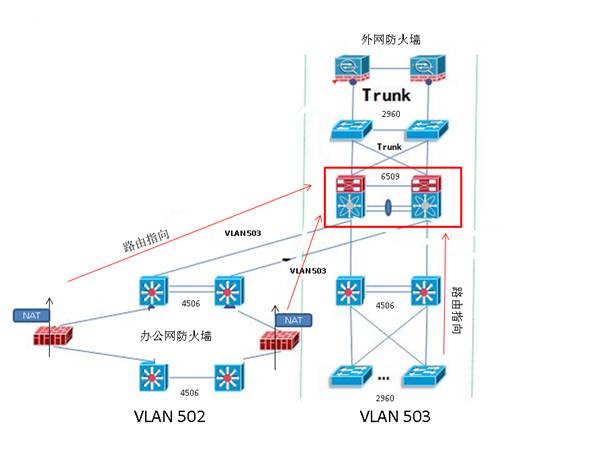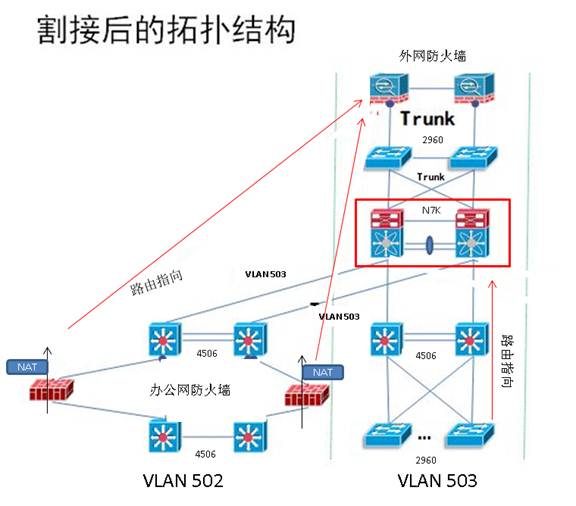N7K替换65引发的意外
硬件平台
N7K, 6509
软件版本
N7K: 5.2(5)
6509:122-33.SXH5
故障发生前的网络状况:

- 内部网络分为2个VLAN,分别是办公网(VLAN502)和业务网(VLAN503);
- 网络中所有的4506和2960交换机只提供2层连接);
- 办公网(VLAN502)的网关在办公网防火墙上,由办公网防火墙做NAT地址转换后转为业务网地址(VLAN503)传出,办公网防火墙的网关指向6509(升级后为N7K)的VLAN 503;
- 业务网(VLAN503)的主机网关直接指向6509(升级后为N7K)的VLAN503;
- 6509(升级后为N7K)上通过默认路由将流量由VLAN503引向外网防火墙。
6509和N7K上interface vlan 503的配置如下:
N7k:
Ip route 0.0.0.0 0.0.0.0 211.151.203.222(外网防火墙地址)
interface Vlan503
description business
no shutdown
ip address 211.151.203.194/27
ip ospf passive-interface
ip router ospf 1 area 0.0.0.0
hsrp version 2
hsrp 503
preempt
ip 211.151.203.193
6509:
(接口相关的OSPF的配置与N7K上完全一致,此处省略)
interface Vlan503
description business
ip address 211.151.203.194 255.255.255.224
standby ip 211.151.203.193
Ip route 0.0.0.0 0.0.0.0 211.151.203.222(外网防火墙地址)
故障的触发原因:
将6509升级为N7K,所有配置做相应命令格式的转换后从6509完整移植到N7K。
设备升级后的故障现象:
- VLAN502上的主机到外网数据传输丢包严重;
- VLAN 503上所有主机到外网数据完全中断。
临时解决方案:
- 将内网防火墙的网关从N7K转到外网防火墙(如下图)上以后,VLAN502的丢包情况消除。

- 检查VLAN503内服务器的配置,发现所有服务器的IP地址都是24位掩码而N7K上VLAN503的地址为27位掩码,将server上的地址掩码改为27位后,VLAN503的数据传输恢复正常。
问题:
- 为什么办公网防火墙的网关指向N7K时办公网VLAN502的数据会丢包而业务网VLAN503没有这个问题?
- 如果VLAN503里的主机因为某些历史原因IP地址的掩码与网关不一致,为什么用6509做网关就没有问题但用N7K就不行?
诊断:
针对问题1:
- 在N7K上用ethanalyzer抓包,发现VLAN503中有大量数据上到CPU,如:
。。。。
Frame 2 (70 bytes on wire, 70 bytes captured)
Arrival Time: Jul 19, 2012 02:14:39.862858000
[Time delta from previous captured frame: 0.000011000 seconds]
[Time delta from previous displayed frame: 0.000011000 seconds]
[Time since reference or first frame: 0.000011000 seconds]
Frame Number: 2
Frame Length: 70 bytes
Capture Length: 70 bytes
[Frame is marked: False]
[Protocols in frame: eth:ip:icmp:ip:tcp]
Ethernet II, Src: 64:a0:e7:3f:60:c1 (64:a0:e7:3f:60:c1), Dst: 00:10:db:ff:40:90 (00:10:db:ff:40:90)
Destination: 00:10:db:ff:40:90 (00:10:db:ff:40:90)
Address: 00:10:db:ff:40:90 (00:10:db:ff:40:90)
.... ...0 .... .... .... .... = IG bit: Individual address (unicast)
.... ..0. .... .... .... .... = LG bit: Globally unique address (factory default)
Source: 64:a0:e7:3f:60:c1 (64:a0:e7:3f:60:c1)
Address: 64:a0:e7:3f:60:c1 (64:a0:e7:3f:60:c1)
.... ...0 .... .... .... .... = IG bit: Individual address (unicast)
.... ..0. .... .... .... .... = LG bit: Globally unique address (factory default)
Type: IP (0x0800)
Internet Protocol, Src: 211.151.230.194 (211.151.230.194), Dst: 211.151.230.201 (211.151.230.201)
Version: 4
Header length: 20 bytes
Differentiated Services Field: 0x00 (DSCP 0x00: Default; ECN: 0x00)
0000 00.. = Differentiated Services Codepoint: Default (0x00)
.... ..0. = ECN-Capable Transport (ECT): 0
.... ...0 = ECN-CE: 0
Total Length: 56
Identification: 0x31a4 (12708)
Flags: 0x02 (Don't Fragment)
0.. = Reserved bit: Not Set
.1. = Don't fragment: Set
..0 = More fragments: Not Set
Fragment offset: 0
Time to live: 255
Protocol: ICMP (0x01)
Header checksum: 0xd564 [correct]
[Good: True]
[Bad : False]
Source: 211.151.230.194 (211.151.230.194)
Destination: 211.151.230.201 (211.151.230.201)
Internet Control Message Protocol
Type: 5 (Redirect)
Code: 1 (Redirect for host)
Checksum: 0x1261 [correct]
Gateway address: 211.151.230.222 (211.151.230.222)
Internet Protocol, Src: 211.151.230.201 (211.151.230.201), Dst: 23.48.17.134 (23.48.17.134)
Version: 4
Header length: 20 bytes
Differentiated Services Field: 0x00 (DSCP 0x00: Default; ECN: 0x00)
0000 00.. = Differentiated Services Codepoint: Default (0x00)
.... ..0. = ECN-Capable Transport (ECT): 0
.... ...0 = ECN-CE: 0
Total Length: 40
Identification: 0x31a4 (12708)
Flags: 0x02 (Don't Fragment)
0.. = Reserved bit: Not Set
.1. = Don't fragment: Set
..0 = More fragments: Not Set
Fragment offset: 0
Time to live: 125
Protocol: TCP (0x06)
Header checksum: 0xe914 [correct]
[Good: True]
[Bad : False]
Source: 211.151.230.201 (211.151.230.201)
Destination: 23.48.17.134 (23.48.17.134)
Transmission Control Protocol, Src Port: 3916 (3916), Dst Port: www (80)
Source port: 3916 (3916)
Destination port: www (80)
Sequence number: 383780779
- 查看这些数据包,发现它们上CPU的原因是为了在CPU上触发ICMP的重定向消息;
- 这些数据包都是从内网防火墙上送过来的,VLAN503里的server没有送数据包到N7K的CPU。
以上三点解释了VLAN502中数据丢包的原因,因为N7K上的COPP会丢弃超限的CPU流量,而这些流量全部都是VLAN502做地址转换后发出的数据包。
* 为什么VLAN503的数据不需要上CPU触发重定向?
到VLAN503的主机(windows系统)上查看相关路由表项,发现这些主机上不仅有默认路由,还有很多到外网的32位主机路由,下一跳指向外网防火墙。很显然,这些32位的路由是windows系统的主机依据N7K发出的ICMP 重定向消息添加的。这些主机在第一次将数据发往自己的网关N7K并收到N7K的重定向消息后就修改了自己的路由表,以后的数据直接交给外网防火墙处理而不再以N7K为网关。
所以问题1的答案是:windows主机会依据ICMP重定向消息修改自己的路由表项而防火墙不会这么做,所以VLAN503的数据只需由N7K的CPU处理一次,而VLAN502的数据则被内网防火墙源源不断地送往N7K的CPU去触发重定向,这些包有很大一部分被N7K依据COPP策略无情地丢弃了。
针对问题2:
问题2的答案其实非常明显,就是代理ARP。ARP-proxy在65的端口上的默认启动而N7K端口上默认关闭,所以即便65上interface VLAN503的IP地址和VLAN503里主机的IP地址掩码不同,它仍然会不辞劳苦地默默为主机提供服务。但在N7K上,在默认关闭proxy-ARP的前提下,N7K因为大家掩码不同而对所有VLAN503内的主机的请求都只是冷眼旁观,失去网关支持的VLAN503中的数据万念俱灰,于是。。。
 反馈
反馈